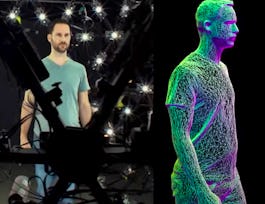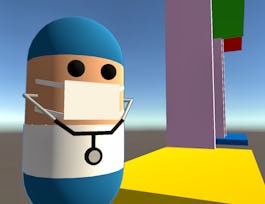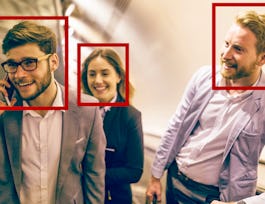This course focuses on the recovery of the 3D structure of a scene from images taken from different viewpoints. We start by first building a comprehensive geometric model of a camera and then develop a method for finding (calibrating) the internal and external parameters of the camera model. Then, we show how two such calibrated cameras, whose relative positions and orientations are known, can be used to recover the 3D structure of the scene. This is what we refer to as simple binocular stereo. Next, we tackle the problem of uncalibrated stereo where the relative positions and orientations of the two cameras are unknown. Interestingly, just from the two images taken by the cameras, we can both determine the relative positions and orientations of the cameras and then use this information to estimate the 3D structure of the scene.


3D Reconstruction - Multiple Viewpoints
This course is part of First Principles of Computer Vision Specialization
Taught in English
Some content may not be translated

Instructor: Shree Nayar
3,465 already enrolled
Included with 
Course
(31 reviews)
Recommended experience
What you'll learn
Develop a comprehensive model of a camera and learn how to calibrate a camera by estimating its parameters.
Develop a simple stereo system that uses two cameras of known configuration to estimate the 3D structure of a scene.
Design an algorithm for recovering both the structure of the scene and the motion of the camera from a video.
Develop optical flow algorithms for estimating the motion of points in a video sequence.
Details to know

Add to your LinkedIn profile
4 quizzes
Course
(31 reviews)
Recommended experience
See how employees at top companies are mastering in-demand skills

Build your subject-matter expertise
- Learn new concepts from industry experts
- Gain a foundational understanding of a subject or tool
- Develop job-relevant skills with hands-on projects
- Earn a shareable career certificate


Earn a career certificate
Add this credential to your LinkedIn profile, resume, or CV
Share it on social media and in your performance review

There are 5 modules in this course
What's included
7 readings2 discussion prompts8 plugins
What's included
1 quiz2 discussion prompts5 plugins
What's included
1 reading1 quiz2 discussion prompts7 plugins
What's included
1 quiz1 discussion prompt6 plugins
What's included
3 readings1 quiz2 discussion prompts6 plugins
Instructor

Offered by
Recommended if you're interested in Algorithms

Columbia University

Columbia University

Coursera Project Network

Columbia University
Why people choose Coursera for their career




Learner reviews
Showing 3 of 31
31 reviews
- 5 stars
87.09%
- 4 stars
6.45%
- 3 stars
0%
- 2 stars
0%
- 1 star
6.45%
New to Algorithms? Start here.

Open new doors with Coursera Plus
Unlimited access to 7,000+ world-class courses, hands-on projects, and job-ready certificate programs - all included in your subscription
Advance your career with an online degree
Earn a degree from world-class universities - 100% online
Join over 3,400 global companies that choose Coursera for Business
Upskill your employees to excel in the digital economy
Frequently asked questions
Access to lectures and assignments depends on your type of enrollment. If you take a course in audit mode, you will be able to see most course materials for free. To access graded assignments and to earn a Certificate, you will need to purchase the Certificate experience, during or after your audit. If you don't see the audit option:
The course may not offer an audit option. You can try a Free Trial instead, or apply for Financial Aid.
The course may offer 'Full Course, No Certificate' instead. This option lets you see all course materials, submit required assessments, and get a final grade. This also means that you will not be able to purchase a Certificate experience.
When you enroll in the course, you get access to all of the courses in the Specialization, and you earn a certificate when you complete the work. Your electronic Certificate will be added to your Accomplishments page - from there, you can print your Certificate or add it to your LinkedIn profile. If you only want to read and view the course content, you can audit the course for free.
If you subscribed, you get a 7-day free trial during which you can cancel at no penalty. After that, we don’t give refunds, but you can cancel your subscription at any time. See our full refund policy.

